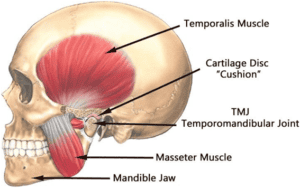Do You Have Jaw Pain? You might have a TMJ Disorder
Read on to find out how we helped Jason, a patient at All Care Physiotherapy, overcome his Jaw pain.
The temporomandibular joint, otherwise known as your TMJ, is the main joint that connects your jaw to your skull. This joint is located just in front of your ears on both sides of your face. Despite having one joint on each side of your face, both joints must work together simultaneously as a unit in order to move your jaw.
Unlike most other joints in your body, your TMJ has a special articular disc in between the joint. The presence of this articular disc essentially splits the joint into two compartments, which helps reduce friction and lubricate the joint for smooth movement.
There are four main muscles that act directly to move and support your TMJ. These muscles and their function are listed below:
| Muscle | Function |
| Masseter |
|
| Temporalis |
|
| Lateral Pterygoid |
|
| Medial Pterygoid |
|

So, what causes TMJ Disorder?
There is rarely a singular cause for TMJ pain; rather it is a result of multiple or a combination of different factors such as:
- Jaw injury (e.g. broken jaw)
- Teeth grinding or clenching
- Arthritis in your jaw joint
- Stress and anxiety
- Overuse or straining jaw muscles (e.g. from taking big bites, excessive chewing)
Common symptoms of TMJ disorders include pain or tenderness around your jaw, pain in your TMJ, aching pain around your ear, difficulty or pain while chewing, and locking of your TMJ/ difficulties opening or closing your mouth.
We have had many patients walk through the door TMJ disorder that have either suddenly come on over the weekend, or persisted over months.
A recent patient of All Care’s, Jason, came to us with pain, clickingand locking of his jaw that was ongoing began over the weekend. At first,Jason tried to ignore the pain; however he soon found it very difficult to chew food when eating. Jasontried taking Panadol to ease the pain, but this was not enough to get rid of his pain completely.
Jason then came to All Care Physiotherapy, where physiotherapy treatment,such as hands-on therapy, soft tissue massage and a gentle exercise program, was provided as a part of his individualised treatment plan. After 2 months of physiotherapy, Jason noticed a significant improvement in his symptoms. He stated that no longer experienced pain, clicking or locking of his jaw and is now able to eat food comfortably and without pain.
Can TMJ Disorders cause Neck Pain?
It is very common for TMJ disorders to also lead to neck pain. Up to 70% of people with TMJ disorders also report a degree of neck pain. Due to how close your TMJ is located, any pain or dysfunction in your TMJ can have a flow on effect to your neck, and vice versa. It is important to let your physiotherapist know if you also suffer from neck pain, because it’s possible that your neck is the underlying cause of your jaw pain.
